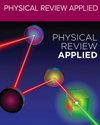Toolbox for nonreciprocal dispersive models in circuit quantum electrodynamics
IF 4.4
2区 物理与天体物理
Q2 PHYSICS, APPLIED
引用次数: 0
Abstract
We provide a systematic method for constructing effective dispersive Lindblad master equations to describe weakly anharmonic superconducting circuits coupled by a generic dissipationless nonreciprocal linear system, with effective coupling parameters and decay rates written in terms of the immittance parameters characterizing the coupler. This article extends the foundational work of Solgun et al. [IEEE Trans. Microw. Theory Techn. 67, 928 (2019)] for linear reciprocal couplers described by an impedance response. Notably, we expand the existing toolbox to incorporate nonreciprocal elements, account for direct stray coupling between immittance ports, circumvent potential singularities, and include collective dissipative effects that arise from interactions with external common environments. We illustrate the use of our results with a circuit of weakly anharmonic Josephson junctions coupled to a multiport nonreciprocal environment and a dissipative port. The results obtained here can be used for the design of complex superconducting quantum processors with nontrivial routing of quantum information, as well as analog quantum simulators of condensed matter systems.

电路量子电动力学非互易色散模型工具箱
我们提供了一种构建有效色散林德布拉德主方程的系统方法,以描述由通用无耗散非互易线性系统耦合的弱非谐波超导电路,其有效耦合参数和衰减率用表征耦合器的惰性参数来表示。本文扩展了 Solgun 等人 [IEEE Trans. Microw. Theory Techn.值得注意的是,我们扩展了现有的工具箱,纳入了非互易元素,考虑了互易端口之间的直接杂散耦合,规避了潜在的奇异性,并包含了与外部共同环境相互作用产生的集体耗散效应。我们用一个与多端口非互易环境和耗散端口耦合的弱非谐波约瑟夫森结电路来说明我们的结果的用途。这里获得的结果可用于设计复杂的超导量子处理器与量子信息的非线性路由,以及凝聚态系统的模拟量子模拟器。
本文章由计算机程序翻译,如有差异,请以英文原文为准。
求助全文
约1分钟内获得全文
求助全文
来源期刊

Physical Review Applied
PHYSICS, APPLIED-
CiteScore
7.80
自引率
8.70%
发文量
760
审稿时长
2.5 months
期刊介绍:
Physical Review Applied (PRApplied) publishes high-quality papers that bridge the gap between engineering and physics, and between current and future technologies. PRApplied welcomes papers from both the engineering and physics communities, in academia and industry.
PRApplied focuses on topics including:
Biophysics, bioelectronics, and biomedical engineering,
Device physics,
Electronics,
Technology to harvest, store, and transmit energy, focusing on renewable energy technologies,
Geophysics and space science,
Industrial physics,
Magnetism and spintronics,
Metamaterials,
Microfluidics,
Nonlinear dynamics and pattern formation in natural or manufactured systems,
Nanoscience and nanotechnology,
Optics, optoelectronics, photonics, and photonic devices,
Quantum information processing, both algorithms and hardware,
Soft matter physics, including granular and complex fluids and active matter.
 求助内容:
求助内容: 应助结果提醒方式:
应助结果提醒方式:


